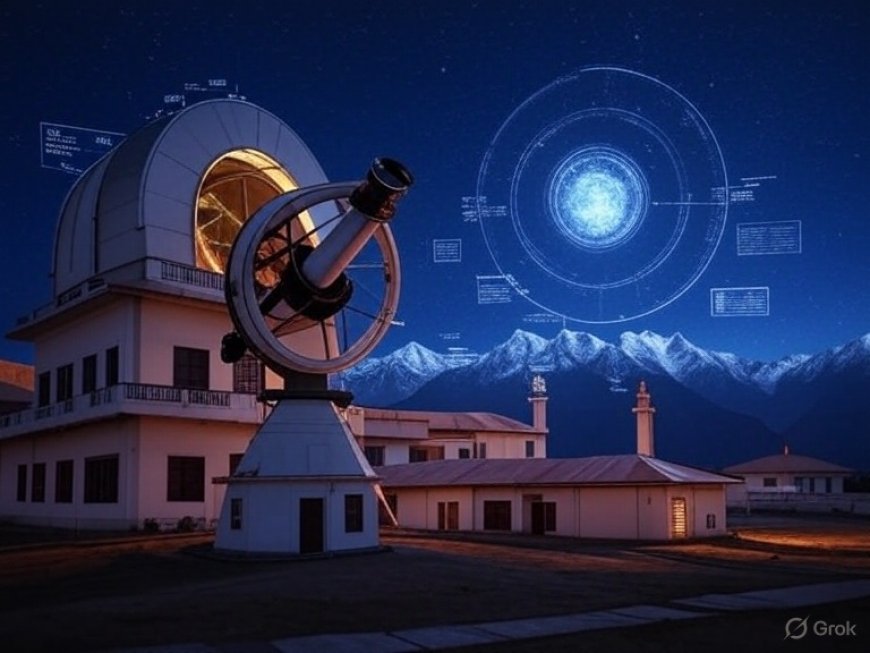India Eyes the Stars: 3I/ATLAS Interstellar Visitor Sparks New Era in National Astrophysics
India joins global astronomers in tracking 3I/ATLAS, the third known interstellar object. Explore how this celestial event advances India's role in space science and boosts its astrophysics footprint.

A Cosmic Encounter: 3I/ATLAS Captures the World's Attention
In an event that echoes the excitement of ‘Oumuamua (1I/2017 U1) and Borisov (2I/Borisov), the international scientific community has confirmed the arrival of a third interstellar object, 3I/ATLAS, on a transient path through our solar system. But what makes this sighting especially significant is India’s active role in the global detection effort, thanks to its growing collaboration with the ATLAS (Asteroid Terrestrial-impact Last Alert System) project.
As space agencies across the globe align to study this rare celestial visitor, India’s astrophysics community is using this moment to highlight its rising stature in observational astronomy and interstellar research.
What is 3I/ATLAS?
3I/ATLAS is the third confirmed interstellar object—a body that originated outside our solar system and is just passing through. Detected by the ATLAS system earlier this year, its highly hyperbolic trajectory, speed, and composition strongly suggest that it originated in a distant planetary system and is not gravitationally bound to our sun.
While details on its size and exact composition are still under study, preliminary observations point toward a comet-like structure with unusual elemental traces—possibly containing organic compounds and ice crystals from beyond the Kuiper Belt, or even outside our galactic neighborhood.
India’s Role: From the Sidelines to the Spotlight
India, through the Indian Institute of Astrophysics (IIA) and Aryabhatta Research Institute of Observational Sciences (ARIES), has joined hands with the ATLAS project, originally spearheaded by the University of Hawaii and NASA. India's observational stations in Ladakh, Nainital, and Bengaluru have contributed to real-time tracking and data collection for 3I/ATLAS.
This is part of a broader national push to establish India as a serious stakeholder in global space science, especially as ISRO gears up for the launch of its Aditya-L1 solar mission and the Gaganyaan human spaceflight program.
For a deeper look into India’s contribution to space science, visit the Indian Institute of Astrophysics and ISRO’s mission portal.
Why 3I/ATLAS Matters to India’s Scientific Future
1. Boosting India's International Space Credibility
By being a direct contributor to tracking a rare interstellar object, India has placed itself at the cutting edge of planetary defense and cosmic event tracking. This opens new doors for partnerships with agencies like NASA, ESA, and JAXA.
2. Accelerating National Astrophysics Programs
The Indian scientific community is using the opportunity to train young astronomers, push forward AI-based data analysis models, and increase investments in optical and radio telescopes.
3. Strengthening Public Interest in Space
Coverage of 3I/ATLAS in regional languages and via educational initiatives like Vigyan Prasar is helping raise public awareness and inspire the next generation of scientists.
Technical Challenges and Observational Breakthroughs
Tracking an object that moves at tens of kilometers per second and originates from outside the solar system poses major challenges. India's participation required:
-
High-speed data relays from Himalayan observatories
-
Collaboration with global databases like Minor Planet Center (MPC)
-
Use of AI-enhanced optics to filter object noise from stellar background
What makes India’s contribution even more meaningful is that it’s done with modest funding, yet with scientific efficiency that has impressed even NASA counterparts.
Political and Strategic Dimensions: Space as Soft Power
India’s involvement in the 3I/ATLAS event also reflects its growing use of space science as a diplomatic tool. With the G20 presidency and initiatives like the Global South Space Cooperation Forum, India is keen to show that it can lead from the front in critical scientific events.
According to Prof. Ravi Bhargava of IISc Bengaluru, “India is no longer a passive observer. With 3I/ATLAS, we’ve entered a new era where Indian telescopes and Indian minds are working in real-time with global experts.”
What We Might Learn from 3I/ATLAS
The object may only be passing through, but the information it carries could be priceless:
-
Clues about the origins of planetary systems
-
Unusual isotopic signatures that challenge existing models
-
Insights into panspermia theory (i.e., the idea that life might travel between star systems on space debris)
Data collected will be shared among all ATLAS participants, and Indian institutes will also publish their own peer-reviewed studies based on localized findings from their observatories.
The Road Ahead: India’s Expanding Astrophysics Infrastructure
To capitalize on such rare opportunities, the Indian government is considering:
-
Expanding sky surveillance infrastructure under ISRO and DRDO
-
Setting up a National Center for Interstellar Studies
-
Funding new international collaborations via INSA and SERB
Explore more on upcoming scientific missions at Department of Science & Technology (DST).
The government’s Science & Tech budget for 2025–26 is expected to allocate a dedicated fund for deep space observation, something that until recently was limited to planetary missions alone.
Global Recognition and the Indian Advantage
India’s relatively unpolluted skies in the Himalayas offer a natural advantage for deep-space observation. Combine this with cost-effective scientific manpower, and India becomes a highly attractive partner for interstellar studies.
India’s ability to contribute meaningful observational data in a short timeframe is now being viewed as a benchmark for space collaboration from the Global South.
Final Thoughts: From Earth to the Stars
The sighting of 3I/ATLAS is a reminder that space is the ultimate frontier, not just scientifically but also diplomatically and politically. For India, this is more than a scientific footnote—it’s a statement of readiness, ambition, and capability.
As the interstellar traveler continues its silent journey past the sun and out of our solar system, it leaves behind more than a trail of dust—it leaves behind a legacy of curiosity and cooperation. And India is now part of that legacy.


















































